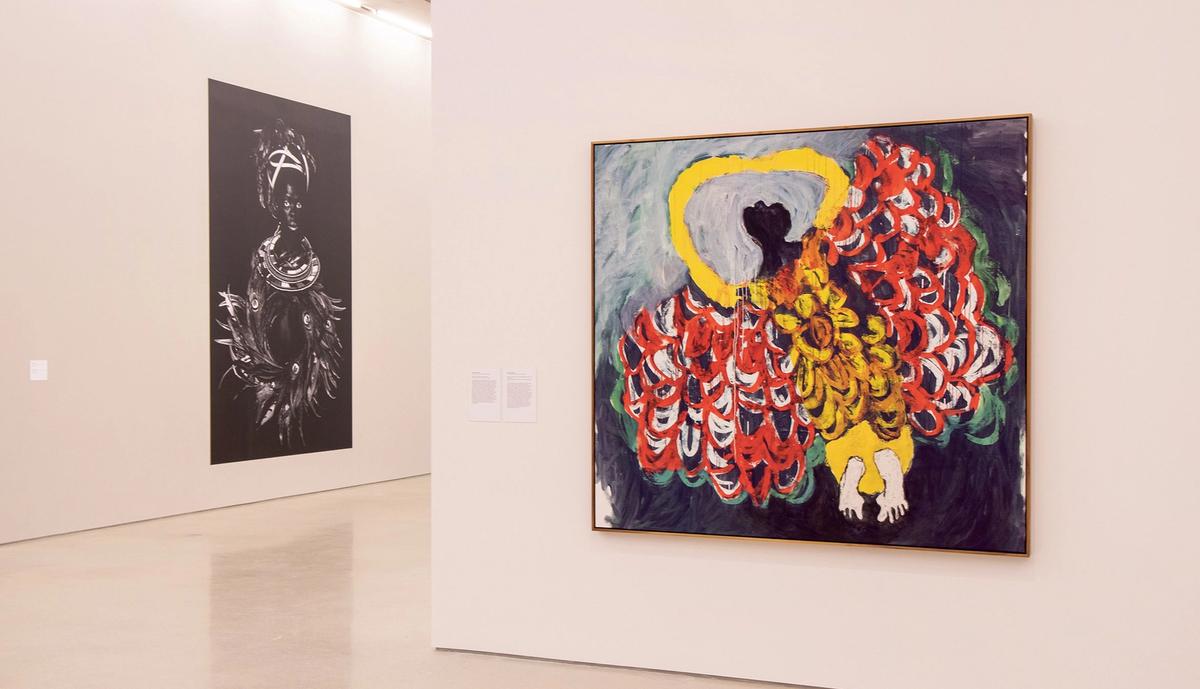In November 2020, as the US reeled from one of the most divisive presidential election cycles in recent memory—when concerns about justice and systemic racism were motivating voters on both sides of the political divide—the Pérez Art Museum Miami (PAMM) opened an exceptionally timely exhibition. Allied with Power: African and African Diaspora Art from the Jorge M. Pérez Collection reflects a particularly rich, nuanced range of experiences, in contrast to the often-simplistic portrayals of Blackness in US media and politics.
“It’s very common to divide and conquer within our communities, but there is a relationship between these different realities that we’re all experiencing,” says María Elena Ortiz, the curator of the show. “Often we experience or we consider Blackness as a monolith, and the exhibition really showcases its diversity, its multiple entry points.”
That diversity is evident in the content and form of the works on view, but also the show’s geographic and generational range. The works by South African artists, for instance, include an arresting, apartheid-era photograph by David Goldblatt, Transkei – Circumcision Initiate in the Hut of the Abakwetha (1975), as well as two large-format self-portraits printed on wallpaper by Zanele Muholi. For Ortiz, the presence of both artists’ works is an opportunity to highlight evolving relationships of power and allyship, rather than drawing a contrast between two different eras. Muholi’s work conveys “how after apartheid, the LGBTQ community was significantly attacked in South Africa”, she says.
Abstraction across the decades
Allied with Power also includes abstract works that evoke dialogues across decades and continents. It features an unusually geometric canvas by Sam Gilliam, Composition with a Rare Blue (1982), which is juxtaposed with a hard-edged abstract painting by the Nigerian American artist Odili Donald Odita, The Door to Revolution (2015). Their pairing, according to Ortiz, underlines “the formal relationship of this older African American artist painting in a particular way in the 1980s, alongside an artist of a younger generation who represents a global idea of a Black artist”.
There is another coupling around abstraction between a recent work by Stanley Whitney, Singtime in Honolulu (2018), and a 1961 canvas by the late Cuban artist Guido Llinás, Pintura Roja (Red Painting). Llinás was “very much interested in gestural painting but also the square”, according to Ortiz. Likewise, Whitney’s compositions foreground squares of bold colour. Bringing together their works, for Ortiz, creates a sense of “our global history of Black abstraction”.
A similarly global history comes into view among the show’s figurative works. These include the irreverent Mickalene Thomas painting Never Change Lovers in the Middle of the Night (2006), which features a reclining figure against a riotously colourful backdrop punctuated with rhinestones, and a classically posed seated portrait by the young Zimbabwean artist Kudzanai-Violet Hwami, An evening in Mazowe (2019). Such works—and others by Genevieve Gaignard, Deborah Roberts and Firelei Báez—cast “the Black female body as a space of pride and redemption”, Ortiz says. The strength and dignity evident in such works provide a vital balance to the power struggles playing out in other parts of the show.
“I remember a co-worker telling me, ‘I was afraid the show was going to be too intense because of the issues it’s dealing with’,” Ortiz recalls. “But the work is beautiful, and the artists’ engagement with colour, in both figuration and abstraction, gives that liveliness and vibrancy to the exhibition.”
• Allied with Power: African and African Diaspora Art from the Jorge M. Pérez Collection, Pérez Art Museum Miami, until 6 February 2022


